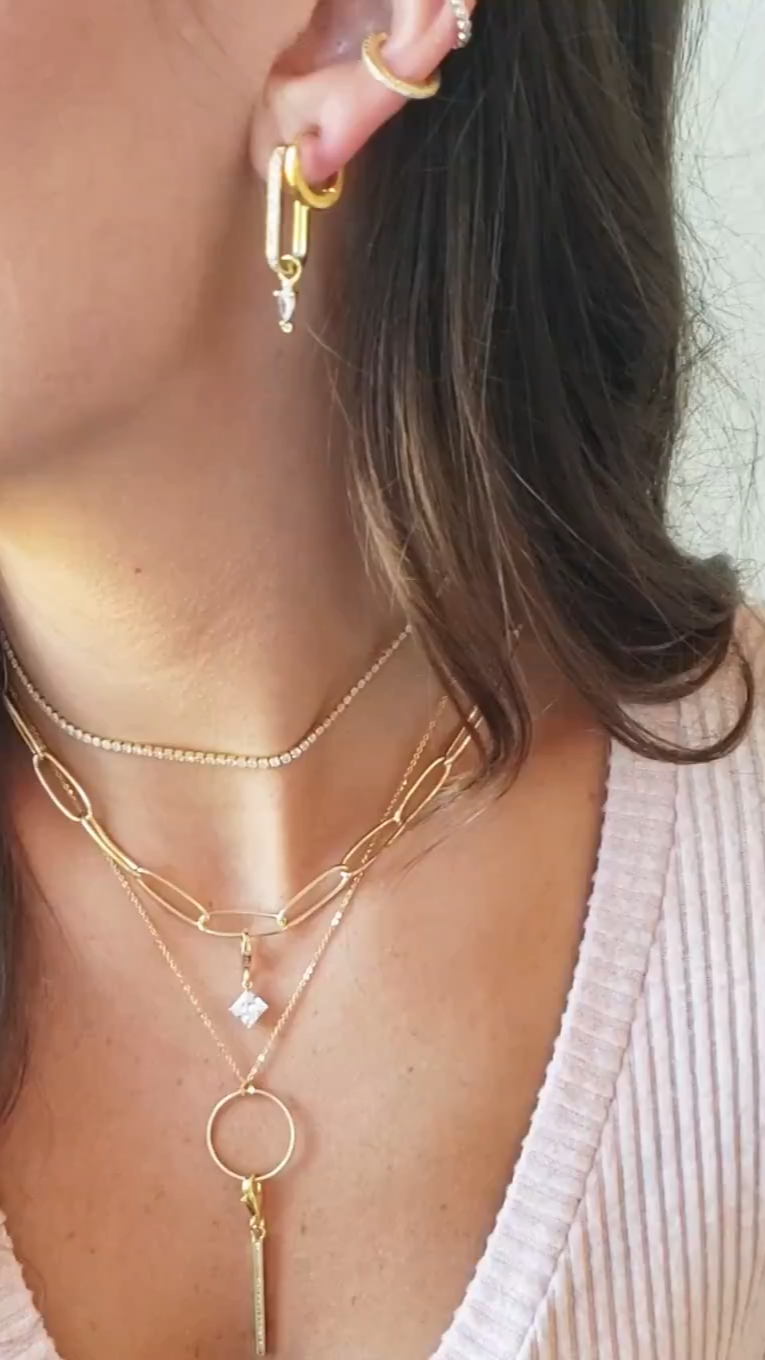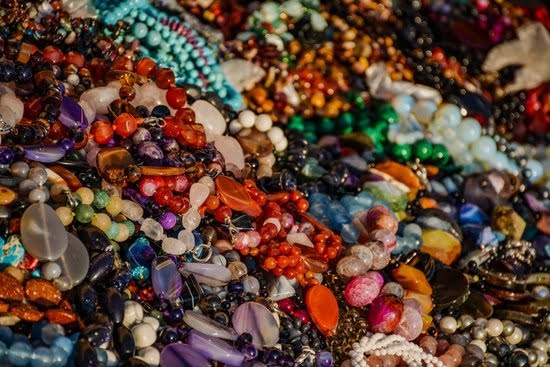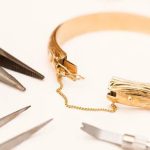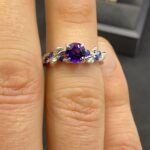Embroidery has long been a cherished art form, but lately, it has found its way into the world of jewelry making. DIY embroidery jewelry is a growing trend that allows crafters to combine traditional stitching techniques with their love for accessories. The allure of handmade, one-of-a-kind pieces and the joy of creating something unique have made this trend increasingly popular.
In this article, we will delve into the world of DIY embroidery jewelry, exploring its origins, techniques, and endless possibilities. We will provide you with essential tools and materials needed to get started on your own embroidered creations. From hoops to threads and beads to findings, we have you covered.
Choosing the right design is crucial when it comes to embroidery jewelry. In the following sections, we will showcase a variety of inspiring patterns tailored specifically for jewelry making. Whether you prefer nature-inspired motifs or personalized monograms, there will be something for every taste and style.
Join us as we embark on a creative journey through DIY embroidery jewelry. From bracelets and earrings to necklaces and pendant keychains, we will guide you step by step through different projects that will elevate your accessories game. So grab your needles and let’s get stitching.
Essential Tools and Materials for DIY Embroidery Jewelry
To create beautiful DIY embroidery jewelry, you will need a few essential tools and materials. These items will ensure that you have everything you need to bring your creative vision to life. Below is a comprehensive list of the necessary tools and materials required for creating embroidered jewelry.
Embroidery Hoops
Embroidery hoops are essential for keeping your fabric taut and in place while you work. They come in various sizes, so choose one that suits the size of your project. Wooden or plastic hoops are both viable options.
Needles
Invest in a variety pack of embroidery needles, as different techniques may call for different needle sizes. Be sure to have thin needles for delicate work and large-eyed needles for threading beads.
Embroidery Threads
Embroidery threads come in different types and textures, such as stranded cotton floss, metallic thread, or silk thread. Choose threads that suit your design and desired effect.
Beads
Beads can add texture, color, and sparkle to your embroidered jewelry pieces. Consider using seed beads, Delica beads, or small gemstone beads to embellish your designs.
Jewelry Findings
Jewelry findings are the components that turn your embroidered pieces into wearable jewelry. You will need findings such as jump rings, clasps, earring hooks, necklace chains, and bracelet findings.
Fabric
Choose a fabric that is suitable for embroidery and durable enough for jewelry use. Cotton fabric is commonly used and comes in a variety of colors and patterns. Alternatively, you could experiment with silk or linen fabrics for a luxurious touch.
These essential tools and materials will provide you with a solid foundation for creating stunning DIY embroidery jewelry projects. Once you have gathered these supplies, you can move on to choosing designs that inspire you and learning the basic embroidery techniques needed to bring your jewelry to life.
Choosing the Right Design
When it comes to DIY embroidery jewelry, choosing the right design is crucial in creating stunning and personalized pieces. The design of an embroidered jewelry piece can make a statement, represent a personal style, or simply add a touch of beauty. In this section, we will explore various embroidery patterns specifically tailored for jewelry making, providing you with inspiration and guidance for your creative journey.
One popular source of inspiration for embroidery patterns is nature. Floral designs are often favored as they convey elegance and a sense of femininity. You can create delicate flowers using satin stitch or French knots, or experiment with different colors and stitches to achieve unique effects. Aside from flowers, animal motifs such as butterflies, birds, or even insects can also be incorporated into your jewelry designs.
Another option is to incorporate geometric shapes into your embroidery patterns. Geometric designs can give an edgy and modern look to your jewelry pieces. Triangles, squares, circles, and other geometric shapes can be easily stitched onto fabric using basic embroidery techniques like cross-stitch or backstitch. You can also combine different shapes and colors to create intricate patterns that catch the eye.
If you prefer a more personalized touch, consider embroidering monograms onto your jewelry pieces. Monogrammed jewelry adds a classy and timeless element to any ensemble. You can choose to embroider initials on pendants or create monogrammed bracelets by stitching decorative letters onto fabric strips before attaching them to bracelet bases.
| Design | Description |
|---|---|
| Floral Wreath | A circular arrangement of embroidered flowers and leaves |
| Geometric Bracelet | An embroidered bracelet featuring a pattern of interlocking triangles |
| Monogram Pendant | A pendant with an embroidered monogram, personalized with initials |
Remember, these are just a few examples to jumpstart your creativity. Feel free to experiment with different patterns and designs that resonate with your personal taste and style. The possibilities are endless when it comes to creating unique DIY embroidery jewelry.
Basic Techniques
Embroidering jewelry is a unique and creative way to make stunning and personalized pieces. This section will provide a step-by-step guide on basic embroidery techniques used in creating jewelry. By learning these techniques, you will be able to create intricate and beautiful designs on your jewelry pieces.
The first technique we will explore is the satin stitch, which is commonly used for filling in larger areas with thread. To do this, start by outlining the shape that you want to fill in with an embroidery hoop and your chosen fabric. Then, bring the needle up from the back of the fabric at one end of the shape, and insert it back down at the opposite end. Repeat this process until the desired area is completely filled in.
Another important technique to learn is French knots, which add texture and dimension to your embroidery pieces. To create a French knot, bring the needle up from the back of the fabric at your desired location. Then, wrap the thread around the needle two or three times (depending on how big you want your knot to be) and carefully insert the needle back into the fabric near where it came out.
Seed bead embroidery is another popular technique used in creating jewelry. This technique involves stitching seed beads onto fabric to create intricate designs or patterns. To do this, start by threading a needle with a double strand of strong thread or beading thread. Then, bring your needle up from the back of your fabric at your starting point and string on a bead before inserting it back down into the fabric right next to where it came up.
By mastering these basic techniques, you will have a solid foundation for creating beautiful embroidered jewelry pieces that reflect your personal style and creativity. Experiment with different threads, color combinations, and design elements to truly make each piece unique and special.
| Embroidery Technique | Description |
|---|---|
| Satin Stitch | Used for filling in larger areas with thread |
| French Knots | Adds texture and dimension to embroidery pieces |
| Seed Bead Embroidery | Involves stitching seed beads onto fabric to create intricate designs or patterns |
DIY Embroidery Bracelets
Embroidered bracelets are a wonderful way to showcase your creativity and add a unique touch to your accessories. Whether you prefer delicate and dainty pieces or bold statement cuffs, there are endless possibilities when it comes to DIY embroidery bracelets. In this section, we will explore different techniques and materials that you can use to create stunning wrist accessories.
One idea for an embroidered bracelet is to create an adjustable bracelet using macrame techniques. Start by selecting a base fabric such as canvas or denim, and cut it into a strip long enough to wrap around your wrist. Next, choose your embroidery design and stitch it onto the fabric using colorful threads.
Once the embroidery is complete, fold the fabric in half lengthwise and cut two small slits near the edges about an inch from each end. Thread a cord through both slits, tying knots at each end to secure it in place. This adjustable bracelet allows you to customize the fit and easily take it on and off.
Another option is to create a cuff bracelet using bead embroidery. Begin by selecting a wide metal cuff blank as your base. Choose a design for your bracelet and transfer it onto the fabric using a water-soluble pen or tracing paper.
Secure the fabric onto the cuff blank using adhesive or small stitches along the edges. Then, carefully stitch beads onto the fabric within the boundaries of the design, creating a beautiful pattern of texture and color. Once all of your beads are in place, trim any excess fabric from the edges and secure it onto the back of the cuff with glue or additional stitches.
Wrap bracelets are another popular style that can easily incorporate embroidery. These bracelets typically consist of several strands of cord wrapped around your wrist with charms or beads added for decoration. To make an embroidered wrap bracelet, begin by embroidering several small motifs onto individual strips of fabric or ribbon using various stitches and colors.
Next, attach one end of each strip to a jump ring or charm holder. Then, gather all of the strips together and begin wrapping them around your wrist, securing the loose ends with a clasp or closure of your choice.
These are just a few examples of the many ways you can create stunning embroidered bracelets. Don’t be afraid to experiment with different techniques and materials to make them truly unique to your style. Whether you’re adding embroidery to an existing bracelet or creating one from scratch, DIY embroidery bracelets are sure to be a beautiful and treasured addition to your jewelry collection.
DIY Embroidery Earrings
One of the most exciting aspects of DIY embroidery jewelry is the opportunity to create statement earrings that are truly unique and eye-catching. With a few basic techniques and some creative inspiration, you can make stunning embroidered earrings that will add a touch of elegance and individuality to any outfit.
When it comes to crafting embroidered earrings, there are various techniques to explore. One popular option is hoop earrings, which provide a simple yet stylish canvas for embroidery. To create hoop earrings, start by selecting small embroidery hoops that are appropriate for the size of your design.
Next, stretch your chosen fabric over the hoop and secure it tightly. Then, begin embroidering your desired pattern onto the fabric using techniques such as satin stitch or French knots. Finally, trim away any excess fabric and attach earring findings to complete the earrings.
Another trendy option for embroidered earrings is tassel earrings. These fun and bohemian-style accessories can easily be customized with colorful threads and beads. To make tassel earrings, start by creating a small wrapped tassel using embroidery floss or thread in your desired color scheme.
Attach the tassels to earring findings using jump rings or wire, and then embellish them with additional beads or charms if desired. Tassel earrings provide a playful twist on traditional embroidery techniques while still allowing for endless creativity.
For those who prefer smaller, more understated designs, embroidered studs are an excellent choice. Stud earrings offer versatility and everyday wearability while still incorporating beautiful embroidery details. To make embroidered studs, select small flat-back buttons or cabochons as the base for your design.
Prepare a stable fabric base by adhering it to the back of the button or cabochon using glue or stitching. Then proceed with embroidering your chosen pattern directly onto the fabric. Finally, attach earring posts or clips to transform them into stylish studs.
Whether you opt for hoop earrings, tassels, or studs, DIY embroidery earrings offer endless possibilities for expressing your personal style and creativity. Experiment with different color palettes, motifs, and techniques to create statement pieces that reflect your individuality. With a little practice and imagination, you’ll soon be turning heads with your one-of-a-kind embroidered earrings.
DIY Embroidery Necklaces
Embroidery necklaces are a stunning way to showcase embroidery as a statement pendant. With their intricate designs and elegant charm, these necklaces can elevate any outfit and add a personal touch to your style. In this section, we will explore how to turn embroidered motifs into beautiful necklace pendants and discuss different necklace styles that you can create with embroidery.
To start off, let’s discuss how you can turn your embroidered motifs into stunning necklace pendants. Once you have completed your embroidery design, carefully cut around the motif, leaving a small border of fabric. This will ensure that the embroidery stays intact and doesn’t unravel.
Next, attach jump rings or small loops to the back of the pendant using needle and thread or jewelry glue. These loops will serve as a way to attach the pendant to the necklace chain.
Now that we have covered the basic steps for creating an embroidered pendant, let’s explore different necklace styles that you can incorporate with embroidery. Chokers are a popular choice for showcasing embroidery as they sit close to the neck, allowing the pendant to take center stage.
Long chains are another option if you prefer a more bohemian or layered look. Statement necklaces with larger embroidery pendants can make a bold fashion statement and add a touch of glamour to any outfit.
When choosing materials for your DIY embroidery necklaces, consider using various types of fabric such as linen or cotton for the base of your pendant. You can also experiment with different colors of threads and beads to add texture and dimension to your design. Additionally, don’t forget about the importance of selecting appropriate necklace findings such as clasps, chains, or cords that complement your pendant.
DIY embroidery necklaces offer endless possibilities for creativity and self-expression. By incorporating intricate embroidery designs into statement pendants, you can create unique pieces that reflect your personal style and make a lasting impression wherever you go. So why wait? Grab your hoops and needles and start exploring the world of DIY embroidery jewelry today.
Unique DIY Embroidery Pendant Keychains and Charms
Creating Fashionable and Functional Accessories
Keychains and charms are not only practical accessories, but they also provide an opportunity to showcase your creativity. With DIY embroidery jewelry, you can create unique pendant keychains and charms that are both fashionable and functional. These small-scale embroidery designs allow for intricate details and customization, making them perfect personalized gifts or statement pieces for your bag.
Designing Your Keychain or Charm
When it comes to designing your DIY embroidery pendant keychains and charms, the options are endless. You can choose from a variety of motifs such as flowers, animals, initials, or even miniature landscapes. Consider the size and shape of your keychain or charm before selecting your design, as certain intricate patterns may be better suited for larger pendants.
Embroidery Techniques for Keychains and Charms
To create embroidered pendant keychains and charms, you can use techniques similar to those used in creating other embroidered jewelry pieces. Satin stitch is a popular choice for filling in larger areas with thread, while French knots can add texture and dimension to smaller elements. Seed bead embroidery can also be incorporated into your design for added sparkle.
Once you have stitched your design onto the fabric base, carefully trim around the edges leaving a small border. Then, attach a jump ring or lobster clasp to turn it into a keychain or charm that can easily be attached to a bag or set of keys.
DIY embroidery pendant keychains and charms offer a fun way to express your creativity while adding a unique touch to everyday accessories. Whether you’re making them for yourself or as gifts for loved ones, these personalized pieces are sure to stand out.
Maintenance and Care for DIY Embroidery Jewelry
Cleaning Handmade Embroidery Jewelry
Proper cleaning is essential to maintain the beauty and longevity of your DIY embroidery jewelry. However, it is important to exercise caution as excessive cleaning can damage delicate embroidery threads or cause them to come loose. To clean your handmade embroidered jewelry, start by removing any dust or dirt using a soft brush or cloth. Gently wipe the surface of the piece, making sure not to apply too much pressure.
For more stubborn stains, you can use a mild soap or detergent specifically formulated for delicate fabrics. Dilute the soap in lukewarm water and dip a soft cloth into the solution. Gently dab the stained area, taking care not to saturate the embroidery with excessive moisture.
Once cleaned, rinse your embroidered jewelry under cool running water to remove any soapy residue. Pat it dry with a clean towel and allow it to air dry completely before storing or wearing it again.
Storing Embroidered Jewelry
To maintain the shape and quality of your DIY embroidery jewelry, proper storage is essential. Avoid exposing your pieces to direct sunlight or excessive heat as these can fade colors and weaken embroidery threads over time. Ideally, store your embroidered jewelry in a cool and dry place, away from humidity.
Consider using individual fabric pouches or jewelry boxes with separate compartments for each piece of jewelry to prevent tangling and possible damage. If you don’t have dedicated storage containers, you can also wrap each piece individually in acid-free tissue paper or cotton fabric before placing them in a larger jewelry box.
Preventing Snags and Damage
Embroidery threads are delicate and can easily catch on rough surfaces or snag on clothing or accessories. To prevent snags and damage to your DIY embroidery jewelry, consider taking the following precautions:
– Remove your embroidered jewelry before engaging in activities that involve contact with rough surfaces or potentially abrasive materials.
– Avoid wearing your embroidered jewelry with clothing or accessories that have rough textures or loose threads.
– Store each piece of embroidered jewelry separately to prevent tangling and potential snags with other pieces.
– When traveling, use a small fabric pouch or dedicated compartment in your bag to protect your embroidered jewelry from being damaged by other items.
By following these maintenance and care tips, you can ensure that your DIY embroidery jewelry remains beautiful and intact for years to come. Embrace the creativity and uniqueness of your handmade pieces and enjoy showcasing them as wearable works of art.
Conclusion
In conclusion, DIY embroidery jewelry offers a wonderful opportunity to embrace your creativity and create personalized pieces that are unique and meaningful. Throughout this article, we have explored the trend of DIY crafts and the allure of handmade jewelry, as well as the essential tools and materials needed for creating embroidered jewelry. We have also discussed various design inspirations and showcased different techniques for creating stunning bracelets, earrings, necklaces, pendants keychains, and charms.
By combining traditional embroidery techniques with jewelry making, you can truly express your individual style and create pieces that reflect your personality. The step-by-step guide on basic embroidery techniques has equipped you with the knowledge to get started, while the ideas provided for different types of jewelry have opened up a world of possibilities.
So why not take a leap into the world of DIY embroidery jewelry? Experiment with different designs, colors, and materials to create pieces that are truly one-of-a-kind. Whether you choose to make them for yourself or as gifts for loved ones, the joy of wearing or gifting something handmade cannot be matched.
In conclusion, let this article be just a starting point for your journey into DIY embroidery jewelry. Explore further embroidery techniques, seek inspiration from nature or personal experiences, and most importantly – let your creativity shine through. Happy crafting.

Welcome to my jewelry blog! My name is Sarah and I am the owner of this blog.
I love making jewelry and sharing my creations with others.
So whether you’re someone who loves wearing jewelry yourself or simply enjoys learning about it, be sure to check out my blog for insightful posts on everything related to this exciting topic!





